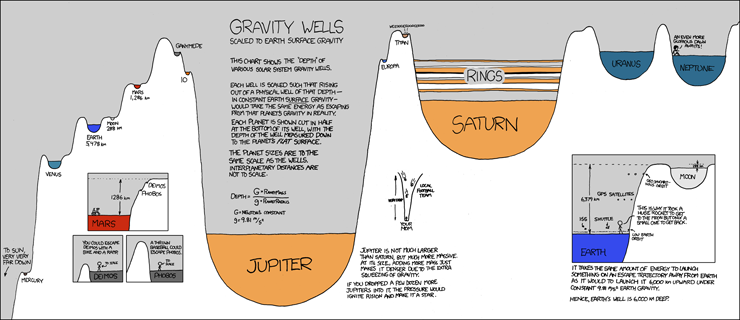December 28, 2009
#681: Gravity Wells explain

Main Text
Gravity Wells scaled to Earth surface gravity
This chart shows the “depth” of various solar system gravity wells.
Each well is scaled such that rising out of a physical well of that depth — in constant Earth surface gravity — would take the same energy as escaping from that planet’s gravity in reality.
Each planet is shown cut in half at the bottom of its well, with the depth of the well measured down to the planet’s flat surface.
The planet sizes are to the same scale as the wells. Interplanetary distances are not to scale.
Depth = (G × PlanetMass) / (g × PlanetRadius)
G = Newton’s constant
g = 9.81 m/s2
Planetary Descriptions
To Sun, very very far down
Mercury
Venus
Earth - 6379 km [originally 5,478 km]
Moon - 288 km
Mars - 1,286 km
Ganymede
Io
Jupiter
[A drawing of a “very deep” gravity well, “Your mom” at the bottom, several member of “local football team” falling down towards her.]
Jupiter is not much larger than Saturn, but much more massive. At its size, adding more mass just makes it denser due to the extra squeezing of gravity.
If you dropped a few dozen more Jupiters into it, the pressure would ignite fusion and make it a star.
Europa
Titan
Two alarms: Weeoooeeoooeeooo
Saturn
Rings
Uranus
Neptune
Megan: An even more glorious dawn awaits!
Mars Inset
[Mars gravity well, with one of the Mars rovers on its surface, with its moons Deimos and Phobos as smaller gravity wells.]
[Figure of a man (to scale) in Deimos’s gravity well.]
You could escape Deimos with a bike and a ramp.
[Figure of a man (to scale) in Phobos’s gravity well.]
A thrown baseball could escape Phobos.
Earth Inset
[Zoomed-in view of Earth/moon gravity well, featuring the relative locations of the atmosphere, Low Earth Orbit, the International Space Station, the Space Shuttle, GPS satellites, and satellites in geosynchronous orbit.]
Cueball: This is why it took a huge rocket to get to the moon but only a small one to get back.
It takes the same amount of energy to launch something on an escape trajectory away from Earth as it would to launch it 6,000 km upward under constant 9.81 m/s2 Earth gravity.
Hence, Earth’s well is 6,000 km deep.